Formulating the Perfect Piece of Cake
INGREDIENTS
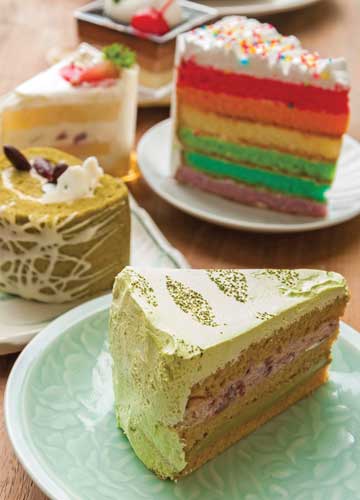 Baking a cake from scratch at home for a family member’s birthday celebration is one thing; baking a cake for sale in a grocery store is another. As long as you use the correct ingredients and follow the recipe, the cake you bake at home is pretty much guaranteed to be moist and delicious. Cake products that are produced for sale in grocery stores, convenience stores, and vending machines have to survive the rigors of industrial processing and packaging, shipping, and shelf life. Some are packaged and sold as ready-to-eat products while others are baked and frozen. Dry ingredients are premeasured and combined into cake mix products to make it more convenient for the harried parent whose child says on the morning of a bake sale, “I need you to bake 36 cupcakes for the bake sale at school today.”
Baking a cake from scratch at home for a family member’s birthday celebration is one thing; baking a cake for sale in a grocery store is another. As long as you use the correct ingredients and follow the recipe, the cake you bake at home is pretty much guaranteed to be moist and delicious. Cake products that are produced for sale in grocery stores, convenience stores, and vending machines have to survive the rigors of industrial processing and packaging, shipping, and shelf life. Some are packaged and sold as ready-to-eat products while others are baked and frozen. Dry ingredients are premeasured and combined into cake mix products to make it more convenient for the harried parent whose child says on the morning of a bake sale, “I need you to bake 36 cupcakes for the bake sale at school today.”
Product developers have to choose the appropriate ingredients and combine them to develop appealing products that can meet the demands of food processing. The information in this article will mostly discuss some of the top concerns that product developers of cake applications have, such as reducing eggs, removing gluten, and replacing sugar and partially hydrogenated oils, and the ingredients that provide function in these circumstances. The underlying issue when developing gluten-free cakes or removing key ingredients like egg whites or certain types of fats, or just developing a shelf-stable cake or cake mix, is texture. “While we have received questions concerning gluten-free, egg reduction, and sugar reduction, our customers continue to be more concerned about general textural issues,” says Steven Baker, food scientist at TIC Gums, White Marsh, Md. (www.ticgums.com). “Common challenges include retaining a moist crumb throughout storage, achieving high volumes in finished cakes, and maintaining consistency of shape from loaf to loaf.”
Cakes Go Gluten-Free
Gluten-free products continue to appear on grocery store shelves and restaurant menus, and with 41% of U.S. adults agreeing that they are beneficial for everyone, according to market research firm Mintel, Chicago, Ill. (www.mintel.com), it is no wonder that food manufacturers are investing in the development of these products. Even though the Celiac Disease Awareness Campaign of the National Institutes of Health estimates that the autoimmune disorder affects about 2 million Americans, market research indicates that other consumers who have not been diagnosed with the disease choose to reduce or eliminate gluten from their diets.
Gluten-free products are found in most food product categories, and that includes cake. “Gluten-free formulating marries the art of baking with the science of food ingredients," remarks Sarah Wood, manager of R&D for Penford Food Ingredients, Centennial, Colo. (www.penfordfoodingredients.com). “A developer must achieve the volume, cell structure, texture, mouthfeel, and shelf life that are created by a gluten matrix without using gluten.”
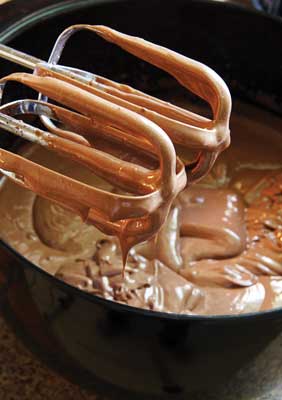 Manufacturers continue to ask for assistance with formulating gluten-free cake products, making it one of the top concerns in cake product development, says Matt Yurgec, bakery and snacks applications team member at Ingredion Inc., Westchester, Ill. (www.ingredion.com/us). Formulating gluten-free products, especially bakery products like cakes, poses unique challenges to product developers. Gluten contributes so much to cake batters and finished cakes, especially in terms of texture and volume. If appropriate ingredients are not used, the finished product is dense and flavorless, and will not appeal to consumers. Wheat flour is removed from the formulation when developing gluten-free cake, and Yurgec explains that depending on the type of flours added back to replace the wheat flour, the finished product could become either very crumbly or too cohesive. Baker adds that formulating with gluten-free flours can result in batters that are thinner in viscosity and less stable, producing an open crumb structure that is inconsistent, firm, and dry.
Manufacturers continue to ask for assistance with formulating gluten-free cake products, making it one of the top concerns in cake product development, says Matt Yurgec, bakery and snacks applications team member at Ingredion Inc., Westchester, Ill. (www.ingredion.com/us). Formulating gluten-free products, especially bakery products like cakes, poses unique challenges to product developers. Gluten contributes so much to cake batters and finished cakes, especially in terms of texture and volume. If appropriate ingredients are not used, the finished product is dense and flavorless, and will not appeal to consumers. Wheat flour is removed from the formulation when developing gluten-free cake, and Yurgec explains that depending on the type of flours added back to replace the wheat flour, the finished product could become either very crumbly or too cohesive. Baker adds that formulating with gluten-free flours can result in batters that are thinner in viscosity and less stable, producing an open crumb structure that is inconsistent, firm, and dry.
Another consideration is cost. “Replacing wheat flour with more expensive ingredients would add cost and make gluten-free products more cost prohibitive to purchase by the consumer,” remarks Wood. “In addition, many gluten-free baked goods have a shortened shelf life due to the product becoming stale with a dry texture. The large proportion of starch in the formula retrogrades rapidly.”
So what are the key ingredients to developing gluten-free cake products that consumers actually want to eat? A blend of non-wheat flours, starches in the cook-up and pre-gelatinized forms, and gums and other stabilizers, for instance, can create successful gluten-free baked goods and provide the functional elements lost when removing gluten, says Wood. To address shelf life concerns of gluten-free cake products, which can dry out and become stale more quickly than cakes formulated with wheat flour, manufacturers can use Penford’s PenPure™ 37 non-GMO native waxy rice starch, PenBind ® 1550 modified tapioca starch, and PenFibe® RO soluble resistant starch with a high water binding ability.
--- PAGE BREAK ---
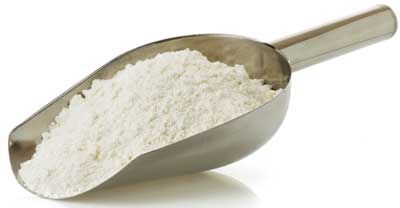 Ingredion’s ingredient range for gluten-free cakes (and other bakery products) includes gluten-free flours and texture improvers. “Modified food starches and clean-label food starches can help to improve the shelf life by managing moisture and reducing the staling rate of a baked good.” One gluten-free flour ingredient, Homecraft ® Create GF 10, can help eliminate the unsatisfactory characteristics while improving the texture and moistness of gluten-free cake, particularly pound cake. This flour, which is a combination of rice flour and tapioca flour and is easy to formulate with, can be used as a “drop-in” replacement for wheat flour in many applications, according to the company. The ingredient is also said to enhance shelf life, making it suitable for use in shelf-stable products, frozen prepared products, and dry mixes. “We also have what we call co-texturizers that can help improve upon the texture or the eating experience of a gluten-free baked good,” says Yurgec. Product developers can even boost the nutritional profile of gluten-free cake products by including pulse flours in the formulations, he adds. Ingredion offers these pulse flours as part of a distributor agreement it formed in 2014 with AGT Food and Ingredients Inc., Regina, Saskatchewan (www.alliancegrain.com). Pulse flours like pea, lentil, and chickpea can be used in combination with starches or other gluten-free flours to produce cakes with improved texture and moisture retention and to enhance the protein, fiber, and vitamin content of gluten-free cakes.
Ingredion’s ingredient range for gluten-free cakes (and other bakery products) includes gluten-free flours and texture improvers. “Modified food starches and clean-label food starches can help to improve the shelf life by managing moisture and reducing the staling rate of a baked good.” One gluten-free flour ingredient, Homecraft ® Create GF 10, can help eliminate the unsatisfactory characteristics while improving the texture and moistness of gluten-free cake, particularly pound cake. This flour, which is a combination of rice flour and tapioca flour and is easy to formulate with, can be used as a “drop-in” replacement for wheat flour in many applications, according to the company. The ingredient is also said to enhance shelf life, making it suitable for use in shelf-stable products, frozen prepared products, and dry mixes. “We also have what we call co-texturizers that can help improve upon the texture or the eating experience of a gluten-free baked good,” says Yurgec. Product developers can even boost the nutritional profile of gluten-free cake products by including pulse flours in the formulations, he adds. Ingredion offers these pulse flours as part of a distributor agreement it formed in 2014 with AGT Food and Ingredients Inc., Regina, Saskatchewan (www.alliancegrain.com). Pulse flours like pea, lentil, and chickpea can be used in combination with starches or other gluten-free flours to produce cakes with improved texture and moisture retention and to enhance the protein, fiber, and vitamin content of gluten-free cakes.
Hydrocolloids also provide distinct functionalities to gluten-free cake applications by improving batter viscosity and stability to produce cakes with good volume and a consistent crumb structure that is soft and moist, says Baker. “Multifunctional in nature, hydrocolloids are versatile ingredients which significantly influence the finished product as well as processability.” These ingredients, he adds, manage water movement to provide freeze/thaw stability, delay moisture loss, and deter firming of the crumb as the product ages through its shelf life. When using hydrocolloids in gluten-free cake formulations, product developers have to pay attention to the amounts that they use because too much is not always a good thing. “Xanthan gum has historically been used for cakes because of its ability to suspend ingredient particulates and contribute to increased batter stability,” remarks Baker. “However, when added at too high of a level, its affinity for water can contribute to a wet and sticky crumb structure in the finished cake. Gluten-free cakes are particularly prone to this since the hydrocolloid usage level is generally higher.” To that end, TIC Gums in 2014 developed Ticaloid ® GF 313, a blend of cellulose gum and xanthan gum that helps enhance the textural attributes of gluten-free cake by developing appropriate viscosity and stability to improve softness and cohesiveness and minimize the development of a wet and sticky crumb.
Palsgaard A/S, Juelsminde, Denmark (www.palsgaard.com), recently reported on how its Emulpals ® 110 activated cake emulsifier, a whipping emulsifier based on polyglycerol esters, brings improvements to gluten-free cakes. In retail and industrial cake mix products, emulsifiers are often used to help improve texture and shelf life. The Emulpals 110 emulsifier system incorporates polyglycerol esters, monoglycerides, and diglycerides that are extruded on a rice starch carrier. Food technologists at Palsgaard developed cake formulas using Emulpals 110 that produced gluten-free cakes that were soft, and had uniform crumb structure, high volume, and a smooth surface.
Whether it is used in gluten-free cake applications or cake applications with gluten, Emulpals 110 is said to be a medium-to-fast-acting emulsifier with an excellent tolerance to long whipping times and have stability during high storage temperatures. The company adds that the ingredient can be easily incorporated into formulations with ingredients like egg powder, cocoa, and oil, and it functions in sponge cakes, Swiss rolls, pound cakes, and more.
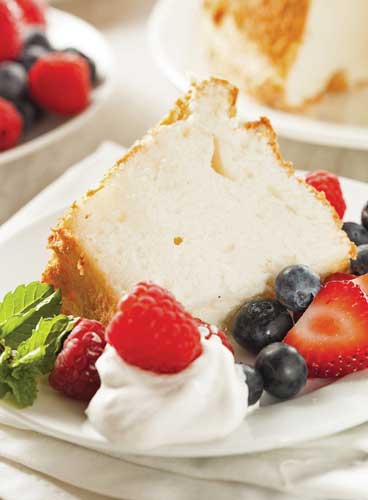 Solutions for Egg Replacement
Solutions for Egg Replacement
“Egg replacement right now is probably one of the biggest issues in the baked goods area because of the drastic rise in egg white prices in the last year or so,” says Yurgec. Indeed, food scientists at other ingredient manufacturers echo this statement. “The single biggest request we see in the cake area is replacing egg whites in angel food cakes,” remarks Vikram Ghosh, bakery technology leader at Cargill Inc., Minneapolis, Minn. (www.cargill.com). “It’s a real challenge because egg whites are so functional in this type of cake. Cargill has been able to successfully replace 50% of egg whites in angel food cake formulas with Gelogen™, a functional system that can be used in many food applications.”
With dried egg white prices reaching as high as $16/pound in 2014 and the prices of other egg products increasing, manufacturers are scrambling to find ingredients to reduce or replace eggs in formulations. Ingredient manufacturers can help product developers control costs in formulas that require eggs. For example, Penford in January 2015 expanded its ingredient portfolio of starches and starch and gum blends that can partially or fully replace whole egg, egg white, and yolk in food products like cake. Yurgec explains that Ingredion is preparing to launch an ingredient system that is a blend of starch, dextrin, and a hydrocolloid said to reduce egg whites in products like cake and angel food cake. Specifically, the ingredient is labeled as potato starch, tapioca starch, and xanthan gum, and will be available in the United States and Canada. The entire bakery industry, not just the cake manufacturers, has been demanding ingredient solutions to replace eggs, or even just to reduce them, says Yurgec. “If you just reduce eggs in a cake application by 25%, there is big cost savings. In some situations, it will make or break some of the smaller companies that are selling in this market where they’re paying that much for egg whites.” He adds that even when egg prices were much lower, the eggs could still make up close to 50% of the cost of a cake formulation. “Now that the price of eggs has gone up dramatically, it becomes even more of an issue for manufacturers.”
--- PAGE BREAK ---
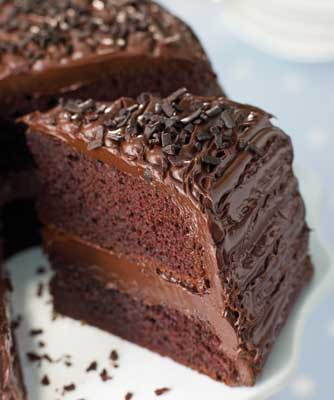 Add Function with Less Salt, Sugar, and Fat
Add Function with Less Salt, Sugar, and Fat
Cake is delicious, but the amounts of sugar and fat in it make it a less-than-healthful food choice. A number of factors are driving food manufacturers to reduce fat, sugar, overall calories, and even sodium in many products, including cake. No doubt consumer demands for healthier food options as well as the 2013 proposal by the U.S. Food and Drug Administration to determine if the Generally Recognized As Safe (GRAS) status should be removed for partially hydrogenated oils are having an effect on product development efforts. Fat, sugar, and sodium have functional benefits in cake formulations, and reducing their amounts will affect the texture, flavor, and overall acceptable eating experience of the finished product. As a result, ingredient manufacturers are working closely with product developers to formulate cake products that have reduced calories, reduced fat/no partially hydrogenated oils, or reduced sugar but still maintain the desired taste and other sensorial qualities that consumers expect. In other words, “healthy indulgence” is a trend that continues to grow.
“The term ‘healthy indulgence’ has many definitions within cake products,” remarks Sharon Book, senior food technologist, bakery, at ICL Food Specialties, St. Louis, Mo. (www.icl-pp.com). “Whatever the desired result, when any change is made to a consumer product, a complete optimization of the overall ingredient formulation is required. The interactions of each ingredient must be carefully considered and tested as each and every ingredient plays its part in the resulting final product.” Take a chocolate cake that is positioned as a healthy indulgence as an example, she says. “A richer, darker chocolate might require a slightly higher pH, which would mean more [baking] soda is needed within the leavening system for the balance of ingredients to help achieve the desired color. While the soda is not one of our ingredients, it is part of the overall leavening system that our products deliver in. Proper leavening is imperative to the final texture and healthy indulgence desired by consumers.”
Across many food categories, including bakery applications like cake, product developers are investigating lower sodium ingredient options. Book explains that ICL’s functional ingredients support the required leavening systems to deliver finished cake products that meet industry and consumer trends such as lower sodium food. “Our vast array of products can be both direct healthy indulgent claim enhancers, such as our calcium-based leaveners, or part of the overall leavening systems of the healthy indulgent item.”
Some types of cakes like angel food cake traditionally do not contain fat but are made with egg whites, which contribute to aeration. In other cakes, volume is developed by butter, oil, or shortening, which also contribute to the mouthfeel and texture. Starches, gums, or combinations of both can be used in cake formulations to mimic the mouthfeel of full-fat products. “ PenNovo® FR is a non-GMO modified food starch that can be used to partially replace solid fat in baked goods,” explains Daniel Bailey, food scientist at Penford Food Ingredients. In addition to this ingredient’s fat mimetic properties, it has a neutral taste and helps maintain volume and cell structure. Bailey also notes that using tara gum or carboxymethyl cellulose will enhance the mouthfeel in reduced-fat cake. " Coyote Brand ® Hydro-Fi XCT-0123 can also be used to replace fat in baked goods while maintaining similar sensory characteristics to its full-fat counterpart.”
Partially hydrogenated oils have functional advantages like improving the texture and taste of foods and, most importantly to manufacturers of processed and packaged foods, the ability to help increase shelf life. Once thought to be a healthier alternative to saturated fats, partially hydrogenated oils, which are a dietary source of trans fats, are now linked to increasing the risk of heart disease, and their fate as an ingredient in foods may soon come to an end as the food industry awaits a final decision by the FDA. In advance of the FDA’s proposal and in the year since, ingredient manufacturers have developed oils and shortenings with no trans fat, and they have also developed technologies to create ones with lower saturated fat and more monounsaturated and polyunsaturated fats for use in cake products and frostings. Bunge, St. Louis, Mo. (www.bunge.com), takes oils and proprietary non-lipid ingredients and through blending and crystallization processes, creates shortenings with zero grams of trans fat, a reduced saturate level of more than 40%, and more monounsaturated and polyunsaturated fat than traditional shortening, according to the company. Bunge food scientists also use an enzymatic process to develop trans-fat-free shortenings for cake frostings.
In addition to reformulating cake products with better-for-you fats, manufacturers are also experimenting with ingredients to help reduce or replace sugar for calorie reduction. “Many of these requests are coming from Latin America where regulatory changes are sparking interest in reduced-calorie products,” says Ghosh. His company, Cargill, has a broad portfolio of ingredients for sugar replacement; the options include high-intensity sweeteners like Truvia® stevia leaf extract, polyol sweeteners like Zerose® erythritol and Sorbidex™ sorbitol, and Oliggo-Fiber® chicory root inulin.
Fibers and resistant starches help to reduce the caloric density of cake by replacing digestible carbohydrate with indigestible or partially digested ingredients such as resistant starches, says Wood. “Resistant starches have a lower caloric contribution than flours, starches, and fat and can be used to reduce the calorie content of baked goods,” she states. Wood explains in greater detail that Penford’s PenFibe RS is a potato-based RS4 resistant starch with 0.5 calories per gram and PenFibe RO is a non-GMO potato-based soluble resistant starch with 1.8 calories per gram. Both of the resistant starches have a calorie count that is significantly lower than the 4 calories per gram from flour or 9 calories per gram from fat. Both provide fiber enrichment, can partially replace flour and sugar, function as texturizers, and are resistant to enzymatic breakdown.
--- PAGE BREAK ---
 Color and Texture for Appealing Cakes
Color and Texture for Appealing Cakes
Cake that is formulated and baked to perfection is delicious on its own, but to add visual interest and additional flavor impact as well as provide a variety of textures, bakers can use frostings, icings, glazes, and inclusions. These are available in a wide palette of colors in shades that range from bright to subdued and in a variety of flavors that appeal to both traditionalists and adventurous eaters. Consumers who love the bacon-in-everything craze had another opportunity to satisfy the craving for bacon flavor with the Betty Crocker Limited Edition Maple Bacon Frosting from General Mills that was sold during the 2014 autumn season.
To improve the structure and stability of frostings and icings, Penford provides starches and maltodextrin. Specifically, its modified tapioca starches, modified waxy corn starches, and rice starches can enhance the water-holding properties of icings and impart creamy mouthfeel and glossy appearance, says Ibrahim Abbas, director of research and development at Penford. In addition to starches, gums play an important role in maintaining the structure and appearance of frostings and icings. Coyote Brand Stabilizer AC-0112, a synergistic blend of gum arabic and carboxymethyl cellulose, helps to provide texture and emulsification to icings, while Coyote Brand Agar provides set, explains Janae Kuc, research & development manager at Gum Technology, a business unit of Penford Food Ingredients, Tucson, Ariz. (www.gumtech.com).
Inclusions deliver flavor, color, and texture as well as enhance nutrition or other desired qualities, and when used in cake applications, they give bursts of flavor and create colorful visual impact, according to Ron Heddleson, senior director of R&D at Qualitech, Chaska, Minn. (www.qualitechco.com). The company produces Flavor-ettes™ inclusions, which can be made with fruit or vegetable ingredients and nutrients like omega-3 fatty acids, fiber, or protein; Flavor-Lites™, which are round, flavor-coated grain-based crisps; and restructured fruits for many applications, including cake. Heddleson explains that benefits of using inclusions rather than real fruit include “improved flavor impact and color consistency, improved protection from sourcing volatility, and significant shelf-life extension and microbiological stability.” Restructured fruit has greater processing stability, he adds, so the visual identity of the piece is more consistent and the flavor impact is preserved.
The inclusions can be formulated to include real fruit content. “Qualitech recently created a raspberry inclusion with real raspberry fruit powder that was consistent in color, look, feel, and aroma, and when cooked, looked like pieces of raspberries,” says Heddleson.
The company also employs encapsulation techniques to help improve flavor delivery and overall performance of the inclusions. “Flavor delivery can be improved over that of real fruit, as the volatiles can be encapsulated within the bit structure,” states Heddleson. “The proprietary processing techniques and formulations used in making encapsulated products have helped bakeries avoid issues with stickiness or smearing of bakery toppings on packaging.”
With such an emphasis on flavor delivery, it is not surprising that the company has available inclusions in a number of flavors like blueberry, pomegranate, pumpkin, tangerine, coconut, peach cobbler, carrot, strawberry, cherry, mango, passion fruit, chocolate, and even bacon for use in cake applications.
Colored film particulates, Spectraflecks™ and Spectraflecks Shapes from Sensient Food Colors, St. Louis, Mo. (www.sensientfoodcolors.com), come in a range of colors (naturally derived, certified, and pearlescent) and precut shapes to add visual appeal as toppings on icing and frosting. Spectraflecks are based on a gum arabic carrier and Spectraflecks Shapes on a hydroxypropyl methylcellulose carrier. They can be formulated to minimize color bleed in certain applications and can be flavored to add an additional dimension to the eating experience. Sensipearl™ mica-based pigment can create iridescent shimmers and luster effects in frostings, while small, spherical shapes called Prills add flecks of color in batters and icings.
While many of the cake products and frostings that contain color often are formulated with synthetic colorings, some product developers are working with coloring ingredient manufacturers to formulate with naturally derived colorings. Kalsec Inc., Kalamazoo, Mich. (www.kalsec.com), manufactures water-soluble naturally derived colorings of shades in the yellow-to-orange range for batters. Formulating cake products with naturally derived colorings can be a bit challenging as these types of colorings are more sensitive to ingredient interactions with other ingredients in the formulation, temperature, pH, processing, and packaging. D.D. Williamson & Co. Inc., Louisville, Ky. (www.ddwcolor.com), offers a range of naturally derived colorings from turmeric, beta-carotene, and annatto that can withstand the elevated temperatures and extended heating time to provide hues in the yellow-to-orange range to cake products. For buttercream frostings and sanding and decorative sugars, the company uses its proprietary oil dispersible technology to add water-soluble colorings to oil-based systems or for plating to ensure even distribution, allowing for new possibilities for naturally derived hues, especially browns, pinks, and purples, says Jennifer Brown, application scientist for D.D. Williamson in a company video (D.D. Williamson, 2013). In the case of buttercream frosting, which is a mix of hard fat and powdered sugar, the technology allows the oil dispersible color to be added to the fat and fully incorporated into the finished product.
Next month’s Ingredients section will examine the roles that spices and seasonings play in food product development.
--- PAGE BREAK ---
Formulating Cake with Microalgae Ingredients
Ingredient manufacturers are now discovering some of the functional benefits that microalgae-based ingredients can bring to food and beverage applications, including cake. Using fermentation to cultivate chlorella, Roquette America, Geneva, Ill. (www.roquetteamerica.com), produces algility™ HL whole algal flour and algility HP whole algal protein. The whole algal flour ingredient is especially useful in bakery products where it is said to help improve the texture and reduce fat.
During the 2014 IFT Food Expo, Solazyme Inc., South San Francisco, Calif. (www.solazyme.com), showed how Algavia™ whole algal flour could produce cake with a total fat content reduced by 45% and saturated fat reduced by 80% compared to a control cake. The Red Velvet Cake Pop product concept that the company distributed during the expo also had reduced cholesterol and calories. The company also reports that this lipid-rich ingredient reduced the use of eggs in the cake formulation and contributed to a soft texture.
Ingredient Roundup
Looking for more ingredient solutions for cake applications? Consider the following options for improvements and enhancements.
• The line of oil and fat ingredients from ADM, Chicago, Ill. (www.adm.com), for use in cake applications includes nonhydrogenated options, enzymatically interesterified oils, and cake margarine. ADM food scientists, who have expertise in the various properties of fats and oils in bakery products, including cake, work to optimize functionalities of these ingredients in customers’ products.
• A soft and tender crumb in cake is made possible by eggs, specifically by egg yolks, which contain fat that helps to slow the rate of firming as a product ages. The fat in egg yolks helps carry flavors, and the carotenoid xanthophyll can contribute color in some lighter-colored cakes. Egg white protein helps to trap air to help build a more uniform structural network that develops the springiness and volume in angel food cake. The American Egg Board, Park Ridge, Ill. (www.aeb.org), has information on these contributions of eggs to cake products and more as well as details about how eggs fit into “clean label” product formulation.
• Ultra Fresh Sweet Supreme 480, Ultra Fresh Sweet Premium 280, and Ultra Fresh Sweet Classic 180 from Corbion Caravan, Lenexa, Kan. (www.corbion.com), are enzyme blends designed to increase and enhance the shelf life of sweet bakery products like cake. “Not only do they extend the freshness date, they can soften the crumb and deliver excellent eating characteristics throughout the life of the products,” says Cheri Tabel, manager of communications and media at Corbion Caravan. The company offers trans-fat-free ingredients under its Trancendim line. The oil-based ingredient systems can provide 50% reduction in saturated fats, are easy to cream, provide aerating properties to the batter, and eliminate hydrogenated oils from the label.
• To create an ultra-smooth coating on cakes, bakers use a sugar paste called fondant. Fondant, which is white but can be colored with food colorings, is rolled out into a sheet, about 1/4-inch thick, draped over the cake, and smoothed to create a base for the addition of other decorations. Domino Specialty Ingredients, West Palm Beach, Fla. (www.dominospecialtyingredients.com), offers a dry fondant with an ultrafine particle size to a smooth, creamy mouthfeel without grittiness under the Bakers Drivert ® line. To produce the fondant, water is added to the dry powder and then blended. The humectant properties of the sugar help to keep the fondant moist and provide for a longer shelf life, according to the company.
• Ingredients like PURE-DENT ® B700 corn starch and INSCOSITY ® B656 instant modified food starch from Grain Processing Corp., Muscatine, Iowa (www.grainprocessing.com), can provide structure and textural properties to gluten-free cakes without leaving the products dry and dense. PURE-DENT B700 corn starch will leave little to no powdery mouthfeel and contributes to the cell structure and volume of the cake. INSCOSITY B656 instant modified food starch can help to increase batter viscosity, improve moisture retention, and develop cell structure and volume.
• Watson, West Haven, Conn. (www.watson-inc.com), provides a line of gluten-free specialty mixes called gluteNONE ™ that can be used to make layer cakes, cupcakes, and snack cakes. The mixes are formulated to produce gluten-free cakes that are comparable in taste and texture to traditional cakes and require only oil and water to be added, saving time and cost, according to the company. To help improve the quality of the icing on the cake, Watson offers UltraSet™ stabilizers that are said to help prevent the frosting from sticking to the packaging, extend shelf life, speed drying, prevent cracking, prevent weeping, and control moisture migration.
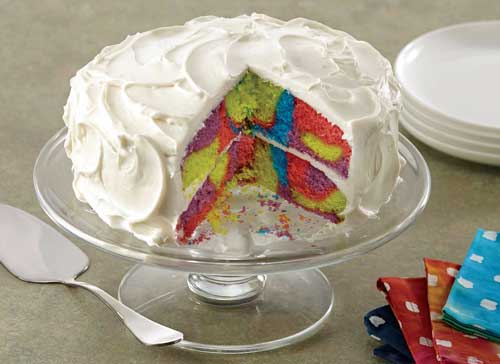 Creative Cakes Make Birthdays Extra Special
Creative Cakes Make Birthdays Extra Special
Celebrate your birthday in style with one of these on-trend birthday cake ideas, courtesy of McCormick & Co. Inc., Sparks, Md. (www.mccormick.com, www.mccormick.com/Recipes/Birthday-Cake). The Mix n’ Match Naked Birthday Cake is a different spin on a traditional frosted layer cake. Here, alternating cake layers and frosting in different colors provide visual interest, as the sides of the cake layers are left bare to showcase the variety of brightly colored frosting in hues that range from bold to neon to pastel.
The Polka Dot Cut-out Cake takes a few extra steps to complete, but it will leave people asking, “How did you do that?” Prepare a white cake batter, divide the batter into three containers, add a different food coloring and extract to each, and pour each batter into separate cake pans and bake. Cool the cake layers and then cut out 1-inch circles with a cookie cutter. Then prepare another white cake batter, divide the batter into three cake pans, and place different colored cake circles in the pans.
For a groovy take on tie dye, prepare the batter for a white cake, divide the batter into four separate bowls, add food coloring to each to create four different colored batters, drop tablespoons of batter randomly into the cake pans, and bake. The result is a whimsical Tie Dye Cake like the one pictured here.
By tinting cake layers and frosting in gradations of orange, bakers can create an ombre effect. For additional impact with this Ombre Cake, add orange extract for flavor, or try other flavor and color combinations.
www.ift.org
Members Only: Read more about cake online at www.ift.org. Type the keywords into the search box at the upper right side of the home page.
 Karen Nachay,
Karen Nachay,[email protected]
